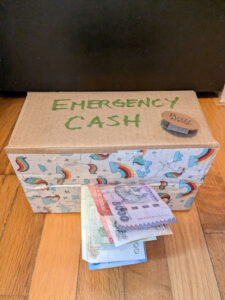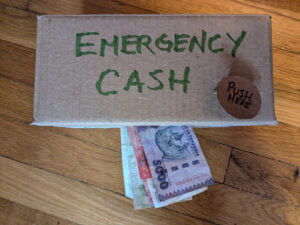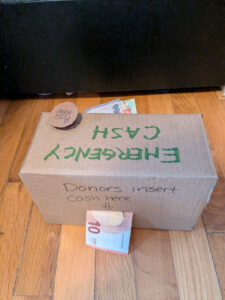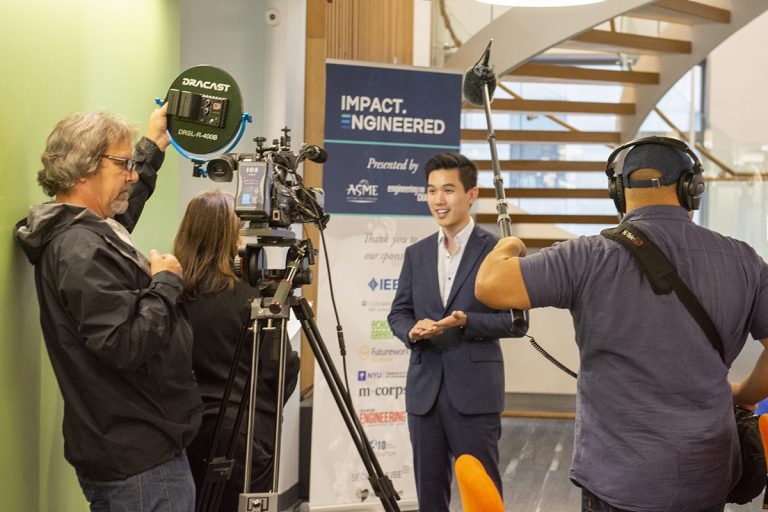Read More: Promising Prototypes to Watch in 2025
Note: CASH is a tongue-in-cheek proposal for a device that is not actually planned for development. The proposal does have a real-world purpose, however. In part, it raises awareness about the efficacy of no-strings money for vulnerable populations. It is also a nudge for donors prone to seeking out the next new gadget. Susan Davis explains below.
Overview
The Portable Emergency Cash Dispenser (CASH) is a secure, lightweight device designed to provide rapid cash assistance in disaster zones and during humanitarian crises. It integrates biometric verification and mobile connectivity to dispense funds directly to beneficiaries, ensuring immediate access to financial resources without the logistical delays of traditional aid. The device can be constructed locally, is solar-powered with a backup battery, operates via satellite or mobile networks, and is designed for deployment by non experts.
- Photo: Susan Davis
- Photo: Susan Davis
- Photo: Susan Davis
Key Features
- Mobile & Satellite Connectivity: Works in remote or infrastructure-compromised areas.
- Preloaded and Digital Wallet Compatible: Can dispense physical cash or transfer funds digitally.
- Rugged and Portable Design: Weather-resistant and lightweight for field deployment.
- Admin Dashboard: Allows real-time tracking of distributions and system diagnostics.
- Biometric & PIN Security: Ensures aid reaches intended recipients while reducing fraud (can be implemented if needed)
Use Cases include
- Natural Disasters: In post-hurricane or earthquake scenarios, CASH provides displaced individuals with cash to purchase food, shelter, transportation, clothing, or whatever they need without waiting for slow-moving humanitarian aid supply chains.
- Conflict Zones: Refugees and internally displaced persons can access financial support without requiring bank accounts.
- Pandemic Response: During COVID-19-like crises, cash transfers minimize physical contact while enabling local economic activity.
- Development & Poverty Alleviation: Can be used in regular cash transfer programs, allowing recipients to invest in their own needs rather than receiving pre-determined goods.
Benefits beyond the cash
- 100% likelihood of use
- Users who are already stressed out experience improved mental health from having the dignity and agency to choose what they need
- By purchasing from local vendors, they are speeding up economic recovery.
- Complements community level activities like temporary shelter
Evidence Supporting Cash Transfers Over Traditional Aid
CASH aligns with these findings by ensuring fast, secure, and dignified cash assistance, empowering individuals to rebuild their lives on their own terms.Studies have repeatedly shown that direct cash transfers are more effective and dignified than traditional in-kind aid.
A systematic review (2024) of 27 studies in Sub-Saharan Africa found that cash “offers greater flexibility, improving mental health and economic resilience in fragile settings.”
International Rescue Committee (IRC) (2023) found that “providing cash directly to crisis-affected individuals is a dignified and effective form of humanitarian aid.”
Village Savings and Loan Associations (VSLAs) (CARE, 2020): Research indicates that VSLAs help communities recover financially post-disaster by leveraging local savings and credit mechanisms to support resilience and economic recovery.
GiveDirectly & Innovations for Poverty Action (IPA) (2019): Research in Kenya and Uganda showed that cash transfers improved food security and long-term investments while allowing recipients to prioritize their own needs.
The Center for Global Development (2018) demonstrated that cash transfers significantly reduce costs associated with procurement, transport, and storage of goods while stimulating local markets.
Mutual Aid Networks (Various Studies): Community-driven mutual aid initiatives have proven effective in crisis response, ensuring faster and more culturally appropriate aid distribution.
Overseas Development Institute (ODI) (2016) found that 18% of humanitarian aid is spent on logistics, highlighting inefficiencies in shipping goods instead of providing cash.
A study in Kenya (2016) found that “unconditional cash transfers have significant impacts on economic outcomes and psychological well-being.”
Read More | The People’s Choice: Promising Prototypes to Watch This Year
Editor’s Note: This is a joke, right?
The Cash Dispenser began as a short reply to a request for suggestions of “promising prototypes” from the Engineering for Change LinkedIn community. In 2025, it can be hard to identify satire in an Internet crowded with good and bad ideas. So, E4C asked the author, Susan Davis, to clarify. The result was this essay, complete with photos of the homemade “prototype.” This is what Ms. Davis says about the Cash Dispenser. (And yes, it is a joke).
“It was more intended to spark different ways of thinking in donors, who are often looking for the next cool gadget, instead of doubling down on the boring basic things that work. For example, getting tap water into the home. Or during emergencies, distributing no-strings-attached cash or vouchers to people so they can buy what they need from local vendors instead of flooding the market,” Ms. Davis told E4C.
About the Author
Susan Davis is a philanthropic advisor championing equitable social innovation. She founded Improve International, served on the boards of Millennium Water Alliance and WASH Advocates, and the advisory committees for DRI’s Circuit Rider and the Water Point Data Exchange. Ms. Davis has worked with the Georgia Institute of Technology, Segal Family Foundation, Water For People, CARE USA, and WaterPartners International (now water.org). She is now on a creative sabbatical, writing a book about her experiences with international development and what could be better.




